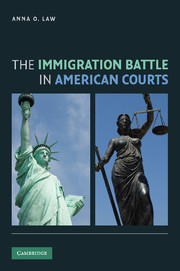Book contents
- Frontmatter
- Contents
- List of Tables and Figures
- Acknowledgments
- 1 Introduction
- 2 How Do We Know What We Know? Data, Methods, and Initial Findings
- 3 The Rise of Two Courts with Differentiated Functions
- 4 Interstitial Policy Making in the U.S. Courts of Appeals
- 5 Institutional Growth and Innovation: The Ninth Circuit Court of Appeals and Immigration
- 6 Continuity Amid Change: The Federal Courts' Commitment to Due Process
- 7 Conclusion
- Appendix A Further Elaboration of Case Selection Methods
- Appendix B Further Elaboration on the Search for Modes of Legal Reasoning
- Appendix C Numerical Codes for Modes of Legal Reasoning
- Appendix D Interview Questions
- Index
- References
Appendix B - Further Elaboration on the Search for Modes of Legal Reasoning
Published online by Cambridge University Press: 04 August 2010
- Frontmatter
- Contents
- List of Tables and Figures
- Acknowledgments
- 1 Introduction
- 2 How Do We Know What We Know? Data, Methods, and Initial Findings
- 3 The Rise of Two Courts with Differentiated Functions
- 4 Interstitial Policy Making in the U.S. Courts of Appeals
- 5 Institutional Growth and Innovation: The Ninth Circuit Court of Appeals and Immigration
- 6 Continuity Amid Change: The Federal Courts' Commitment to Due Process
- 7 Conclusion
- Appendix A Further Elaboration of Case Selection Methods
- Appendix B Further Elaboration on the Search for Modes of Legal Reasoning
- Appendix C Numerical Codes for Modes of Legal Reasoning
- Appendix D Interview Questions
- Index
- References
Summary
I identified the modes of legal reasoning through a close reading of the opinions to ascertain the primary (and sometimes secondary) rationale that judges used to justify the legal outcome. I did not work from a preconceived list; instead, as new modes of legal reasoning appeared, I added them to the list. To find the modes of legal reasoning, I could not simply scan for keywords, because, in many instances, judges would refer to one mode of legal reasoning by using varying rhetorical references. For example, a common mode of legal reasoning cited in Supreme Court cases was congressional plenary power over immigration and attendant judicial deference. Without ever writing the words “plenary power,” numerous opinions referred to immigration as a subject that was the province of the political branches, or to the Congress or the executive (rather than the judiciary) as the “proper branch” to decide immigration issues. The use of keyword recognition software that would scan for certain words, or even a keyword search for “immigration” and “plenary power” in Lexis/Nexis, would have missed many of the plenary power cases.
In many other instances, judges ran through a list of possible legal reasoning and systematically ruled them out one by one before actually settling on one approach to justify the outcome in the case. In such an instance, a reader would have to read the opinion in its entirety to understand and identify the preferred mode of legal reasoning on which the outcome was actually based.
- Type
- Chapter
- Information
- The Immigration Battle in American Courts , pp. 241 - 244Publisher: Cambridge University PressPrint publication year: 2010



